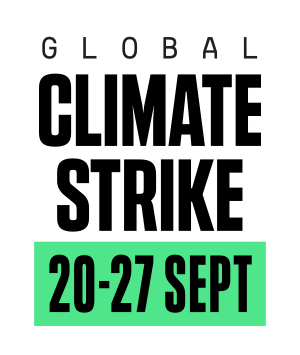| September 2019 climate strikes | |
|---|---|
| Part of the school climate strikes | |
 | |
| Date | 20–27 September 2019 |
| Location | Global |
| Caused by | Climate change concerns |
| Methods | Protest |
| Lead figures | |
| Number | |
| between 6 – 7.6 million, globally[1][2] | |

The September 2019 climate strikes, also known as the Global Week for Future, were a series of international strikes and protests to demand action be taken to address climate change, which took place from 20 to 27 September 2019. The strikes' key dates were 20 September, which was three days before the United Nations Climate Summit, and 27 September.[3][4] The protests took place across 4,500 locations in 150 countries.[5][6] The event stemmed from the Fridays for Future school strike for climate movement, inspired by Swedish climate activist Greta Thunberg.[7][8] The Guardian reported that roughly 6 million people participated in the events,[1] whilst 350.org – a group that organised many of the protests – claim that 7.6 million people participated.[2]
The 20 September protests were likely the largest climate strikes in world history.[9][10] Organisers reported that over 4 million people participated in strikes worldwide,[9] including 1.4 million participants in Germany.[11][12] An estimated 300,000 protesters took part in Australian strikes,[13] a further 300,000 people joined UK protests[14] and protesters in New York – where Greta Thunberg delivered a speech – numbered roughly 250,000.[4][10] More than 2,000 scientists in 40 countries pledged to support the strikes.[15]
A second wave of protests took place on 27 September,[16] in which an estimated 2 million people took part in over 2,400 protests.[1][17] There were reported figures of one million protesters in Italy,[18] and 170,000 people in New Zealand.[19] In Montreal, where Greta Thunberg spoke, the Montreal school board cancelled classes for 114,000 of its students.[20][21] An estimated 500,000 protesters, including several federal party leaders, joined the march in Montreal.[22][23]
- ^ a b c Taylor, Matthew; Watts, Jonathan; Bartlett, John (2019-09-27). "Climate crisis: 6 million people join latest wave of global protests". The Guardian. Retrieved 2019-09-28.
- ^ a b "Global climate strike gathers 7.6m people". Hürriyet Daily News. 2019-09-29. Retrieved 2019-09-30.
- ^ Feller, Madison (2019-09-17). "The World Is Burning, and Teens Are Fighting: What to Know About the Global Climate Strike". Elle. Archived from the original on 2019-09-20. Retrieved 2019-09-19.
- ^ a b Cite error: The named reference
CNN Melbournewas invoked but never defined (see the help page). - ^ Milman, Oliver (2019-09-20). "US to stage its largest ever climate strike: 'Somebody must sound the alarm'". The Guardian. Archived from the original on 2019-09-20. Retrieved 2019-09-20.
- ^ Tollefson, Jeff (2019-09-18). "The hard truths of climate change – by the numbers". Nature. Archived from the original on 2019-09-19. Retrieved 2019-09-20.
- ^ "Inside The Youth-Led Plan To Pull Off The Biggest Climate Strike So Far". MTV News. Archived from the original on 2019-09-20. Retrieved 2019-09-19.
- ^ Weise, Elizabeth (2019-09-19). "'It's our future that's at stake': US students plan to skip school Friday to fight climate 'emergency'". USA Today. Archived from the original on 2019-09-19.
- ^ a b Barclay, Eliza; Resnick, Brian (2019-09-20). "How big was the global climate strike? 4 million people, activists estimate". Vox. Archived from the original on 2019-09-21. Retrieved 2019-09-21.
- ^ a b Cite error: The named reference
Guardian globewas invoked but never defined (see the help page). - ^ Cite error: The named reference
Germany strikerswas invoked but never defined (see the help page). - ^ "Rekordzahlen bei Klimademos: In Deutschland demonstrieren 1,4 Millionen Menschen". zdf.de (in German). Retrieved 2019-09-21.
- ^ Cite error: The named reference
abcwas invoked but never defined (see the help page). - ^ Cite error: The named reference
UK totalwas invoked but never defined (see the help page). - ^ Conley, Julia (2019-09-20). "'Students Have Led and We Must Follow': Thousands of Scientists From 40 Nations Join Global Climate Strike". Buzz Flash. Retrieved 2019-09-21.
- ^ Taylor, Matthew; Bartlett, John (2019-09-27). "Fresh wave of climate strikes takes place around the world". The Guardian. Retrieved 2019-09-27.
- ^ Giuffrida, Angela (2019-09-27). "Italian minister urges pupils to skip class for global climate strike". The Guardian. Retrieved 2019-09-27.
- ^ Cite error: The named reference
Repubblica millionwas invoked but never defined (see the help page). - ^ Cite error: The named reference
NZ Heraldwas invoked but never defined (see the help page). - ^ Cite error: The named reference
GlobeAndMailwas invoked but never defined (see the help page). - ^ Cite error: The named reference
Montreal cancelledwas invoked but never defined (see the help page). - ^ Murphy, Jessica (2019-09-27). "Hundreds of thousands join Canada climate strikes". BBC. Retrieved 2019-09-28.
- ^ Riga, Andy (2019-09-28). "As it happened – 500,000 in Montreal climate march led by Greta Thunberg". Montreal Gazette. Retrieved 2022-09-22.